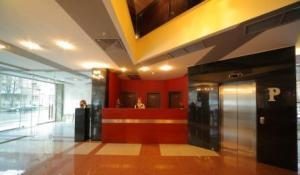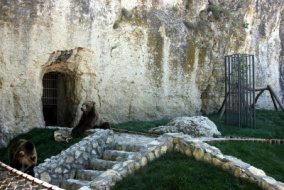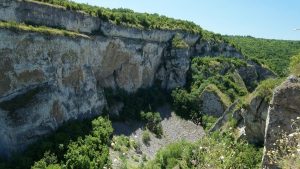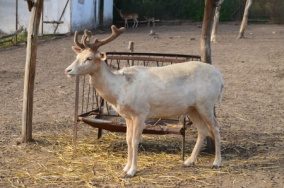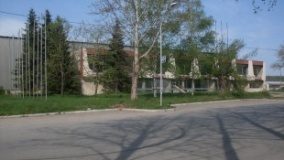

In 1977, on the occasion of the 100th anniversary from the liberation of Pleven, on the real battle field, in the Skobelev park it is built the museum Panorama “the Epical Pleven 1877”.
The authors of the architecture design are Plamena Țaceva and the colleague of the design team Ivo Petriv. The construction for the recollection started on the 19th of January, 1977. The official opening was made on the 10th of December 1977, the day of the centenary for the liberation of Pleven.
Nikolai Vasilievici Ovechkin / military studio “M. Grekov” – the city of Moscow, Russia / is the author of the picturesque part, the general entrepreneur and the leader of the team of 13 Russian and Bulgarian artists: V.Shterbakov I. Kabanov, A. Chernyshov, M . Ananiev N. Ovechkin, D. Donchev, V. Esaulov, V. Lemesheva, Hr. Boyadzhiev, D. Esaulov, V. Tautiev, Y. Usipenko A. Trotsenko.
The building has the shape of a cone body, carried by four styled bayonets. Three horizontal ring symbolize the three attacks on Pleven, whereas the ring with the bayonet – the blocking of the city. The height of the armor with the bayonet is of 47 m, the total dislocation is of 54.000 m3.
The panorama the “Epical Pleven 1877” is formed of four auditoriums: introductive, panorama, diorama and final.
the introductive auditorium – Six painting / 4 x 3, 60 m / reflects moments from the history of Bulgaria and of the Russian – Turkish war from 1877 – 1878
the ottoman domination
the revolt from April
The Parade from Sankt – Petersburg in the support of the Bulgarian people
the Russian army passes the Danube
The Battle from Shipka
The Panoramic Auditorium – Panorama canvas / 115 x 15 m / hatched from flax, with a connector of vertical seam and it is assembled in a room with a diameter of 40 meters. Its total surface is of 2375 m2. The perspective of the image is of 8 – 10 km.
On the panoramic canvas it is recreated the biggest and the bloodiest battle for Pleven – The third assault – the eleventh – the twelfth of September 1877 /. The visitor is situated in the center of the battle field on the highest hill from the proximity of the city, and the positions of the Turkish army are between the redoubts “Kovanlak” and “Isa-aga”. There can be seen the city and the Turkish parts which surround the numerous hills, attacking the Russian and the Romanian troops, which defend the location, the Russian commanders and the central office of Osman Pasa. On this day, Russia and Romania attack the eastern, the south – western and the southern city. The central place presents the battles fought from the southern part, commanded by the general M. D. Skobelev. With the help of the art instruments and of the paint there are recreated the drama and the tension from the green hills, when the Russian soldiers escaladed under the enemy fire, the hard Turkish fortifications “Kovanlak” and “Isa – aga”.
It is presented the culminant moment, when after exhausting all the reserves, the general Skobelev, famous not only for his military talent, but, also, for his personal courage, he himself the lance tip of the team, further commanded the attack.
After a short body – to – body fight, “Kovanlak” was captured, and one hour later also fell “Isa – aga”. Firstly the Turkish defense was broken in all of its depth and then it was found the road towards Pleven. For a period of 30 hours, without rest and support, the troops of Skobelev drive five Turkish counter attacks. The other two divisions didn’t succeed, and the Russian army retreats even on the 11th of September.
the team
The artistic team commanded by N. V. Ovechkin
round
Interior view of the panorama
introductive room
introductive room
Click here to see the entire canvas
the panoramic hall
The diorama auditorium
The diorama auditorium
The final auditorium
The final auditorium
There continues to fight only the Skobelev army with two thirds from the army of Osman Pasa. The Russian commanders already evaluated this thing that an attack without a success, and they didn’t offer support. The last defenders of the green hills, the soldiers who ended their debt, leaving a bloody hill at the principal order under the Russian command of the hour 17 on the 12th of September.
In the ensemble composition of the battle field is redeemed a place where there were fulfilled the humanitarian duties by the Russian doctors, the trained nurses and the paramedics. The Russian army has the complete help and of the local Bulgarian population.
With all this chivalry, courage and resistance of the Russian and of the Romanian soldiers, the third assault ended with a failure. There are given many sacrifices. Only in the army of the General Skobelev there were killed and injured 6500 people, therefore the valley from the front of the Turkish forts was soaked into their blood; it is called “Dead”. The total loses in the Romanian army are around the value of 3000 deceased and injured and from the Russian side – approximately 13.000.
A failure and numerous victims require a tactical change. Planned and commanded by the general Totleben, started the trimestrial blocking of Pleven. Physically exhausted, filled with uncertainty and fear, the Turkish army was forced to make a fatidical choice.
Diorama Hall – painting / 17/ 5 m / reflects the last battle for Pleven in the Valley of the river Vit from the 10th of December 1877. The total surface – 150 s.m.
On the date of the 28th of November / the 10th of December / 1877, after three months of isolation, Osman Pasa tries to break the line of the blockade and to retreat in Sofia. In the valley of the river Vit, after a bloody fight of half a day the Grenadier Body commanded by the General Ganetskiy defeated and captured 43, 000 soldiers from the Turkish army. There was defeated one of the most talented Turkish commanders – the marshal Osman Pașa. There are also captured 10 pași, 128 officers of major state, 77 towers and many military flags.
The renting auditorium has two paintings / 4 x 3, 60 / with the show of the capitulation of Osman Pasa and the crossing on the winter time of the mountain, by the Russian army.
The liberation of Pleven was a turning point in the period of the Russian – Turkish war. The Russian army passed the most difficult obstacle in its path, which was possible to be realized with the help of the specialists in the developed military operations – the crossing in the period of winter of the mountain. Only after one month and a half after the falling of Pleven, the Turkish government demands peace. On the 19th of February / the 3rd of March / 1878 was signed the peace treaty from San Stefano between Russian and Turkey, in which Bulgaria re-established its statehood.
We can see the military uniforms, the weapons and the artillery equipments from the Russian – Turkish war from 1877 – 1878, which completes the art exhibit in the final room.
We also have a permanent exhibit with original lithography from the XIXth century. Disposed in the Round Panorama the “Epopee of Pleven 1877”, it is united with the theme of the liberation and it presents moments from the Russian – Turkish war from 1877 – 1878 and episodes from the battles of national liberation from the Bulgarian Renaissance. The most important of them are the battles of the troops of Hadji Dimitar and Ștefan Karadzha, executed in the period or immediately after the reported events, the presented lithography is exact history.
The exhibit completes the artistic works of the Bulgarian, Russian and established Romanian authors. The pictograms of the dome D. Danchov, the sculpture of the figure of the general M. D. Skobelev / author A. Spasov / the busts of the military leaders, participants at the Russian – Turkish war from 1877 – 1878 / the writers P. Trubetzkoy and F. Storck / the graphics Sidonia Atanasova, reflecting on the epic Pleven and the contest of original projects for building a mausoleum – chapel “Saint George the Over Comer” from Pleven / 1903 /.

